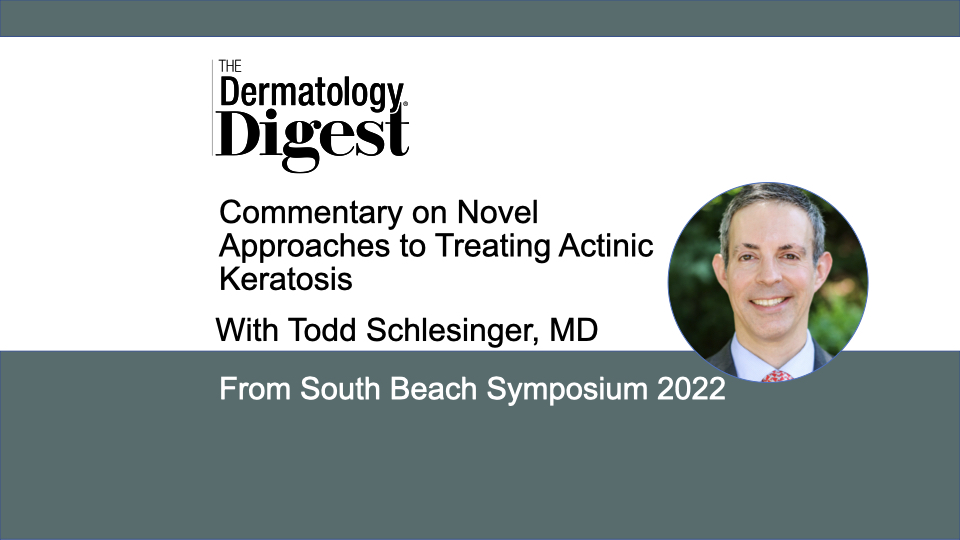Dr. Todd Schlesinger discusses new and novel topical approaches for treating actinic keratosis, including improved efficacy, tolerability, and patient adherence.
Todd Schlesinger, MD, is Medical Director, Dermatology and Laser Center of Charleston and Clinical Research Center of the Carolinas, Charleston, South Carolina
“The types of treatments that we’ve done traditionally—cryosurgery, freezing, topical treatments, such as 5-fluorouracil and imiquimod… and of course photodynamic therapy—all have approvals for the treatment of actinic keratosis,” said Todd Schlesinger, MD, who presented “Novel Approaches to Treating Actinic Keratosis” at South Beach Symposium 2022.
“Our patients are looking for us to be giving them the most innovative treatments; giving them the best outcomes; trying to reduce adverse events. The Holy Grail is excellent adherence and excellent efficacy with high tolerability.”
New topical tirbanibulin (Klisyri, Almirall) offers all three: efficacy, a tolerable adverse event profile, and a higher likelihood of patient adherence, said Dr. Schlesinger.
“Tirbanibulin is the newest approved topical for actinic keratosis [AK] based on the inhibition of microtubule formation and cell division. It’s at the G2 phase of cell division that is primarily inhibited during the cell replication cycle. And, therefore, that helps to interrupt the growing actinic keratosis and cause clearance.”
Because it only temporarily binds at the receptor site, patients effectively tolerate local reactions, said Dr. Schlesinger.
“We’re also seeing good clearance rates, an approximately 49% complete clearance rate, with tirbanibulin in the two large phase 3 studies1 that were conducted and published last year at day 57.”
Approximately 75% to 80% of patients had a partial clearance rate. All patients had 4 to 8 AK lesions on the face or scalp in a 25 cm2 area, he said.
The short treatment course with tirbanibulin also means a better chance of patient adherence, said Dr. Schlesinger.
“We’re talking about a five-day application: One packet per day applied to the area for a period of five days, with peak adverse events occurring at approximately day 8 and usually gone by day 29.”
Combination Therapies
5-fluorouracil is often a component of effective combination therapies, said Dr. Schlesinger.
“I think the number one most important combination therapy that’s being used clinically now is the 5-fluorouracil-calcipotriol compound, which is two on-label medications being used in a compound.”
5-fluorouracil works well but also comes with an undesirable adverse event profile, said Dr. Schlesinger. Using it in combination helps.
“The theory behind using this combination is that the vitamin D calcipotriol induces thymic stromal lymphopoietin, which is an epithelium-derived cytokine that regulates allergic inflammation in the skin. It also may convey anti-tumor response through upregulation of T cell infiltration.”
For patients with large areas of field precancerization on the lower extremities, 5-fluorouracil chemo wraps can be helpful, especially for those who have vascularly compromised skin and are unable to safely undergo traditional treatment, said Dr. Schlesinger. The risk of toxicity can be reduced by wrapping one area at a time, such as one leg or one arm.
“Chemo wraps using 5-fluorouracil under, for example, a calamine dressing. A wound wrapped dressing, such as an Unna Boot, can help to concentrate the 5-fluorouracil there.”
Topical Immunotherapy
Immunotherapy is approved for treating squamous cell carcinoma (SCC), which has a high tumor mutational burden. As the precursor to SCC, AK also has a high number of mutations that may also benefit from immunotherapy, said Dr. Schlesinger.
“Tumors have a way of tricking the immune system T cells into thinking they’re normal, or what we call the sense of self, by exhibiting PD-L1 receptors on their surface which interact with PD-1 receptors on T cells.”
Topicals like imiquimod stimulate the production of cytokines such as tumor necrosis factor and interferon alpha, enhancing the immune mediated attack on cells with a high mutational burden, such as AK, said Dr. Schlesinger.
“On the other hand, with immunotherapy, once the checkpoint is blocked, T cells do not recognize tumor cells as self. They see them for what they are, and they attack. They go into infiltration mode, and CD8-positive T cells release cytokines within the tumor that cause tumor destruction.”
Photodynamic Therapy
Photodynamic therapy is currently approved with two different concentrations of 5-aminolevulinic acid (5-ALA): one for use with blue light; one for use with red light. These are being used in different ways to improve outcomes, said Dr. Schlesinger.
Many physicians are performing blue light contact incubation in a shorter period of time than 18 hours per the manufacturer label.
“Some people are using thermal photodynamic therapy, where the theory is that heating the area with a warming blanket or with another method during incubation can help to improve the efficacy of treatment by enhancing 5-ALA uptake and protoporphyrin IX formation.”
Phototherapy with methyl aminolevulinate is not yet approved in the United States but is being investigated, he said.
A Common Goal
Of the various topical treatments available, dermatologists may find different ways to use and combine them for treating AKs, said Dr. Schlesinger.
“Every one of these topicals have their different mechanism of action for a common goal of eliminating AK. We do rely on the body’s immune system to help in our treatments.”
The future may hold different versions of imiquimod, potassium hydroxide (KOH) 5% solution, and more.
“I think that each practitioner may find their niche when it comes to how to combine the treatments. But the key is that since we have more options available now, and hopefully more coming in the future, we’ll be able to better control actinic keratosis and hopefully reduce the progression to squamous cell carcinoma.”
Disclosure: Dr. Schlesinger is investigator, consultant, speaker for Almirall, Galderma, SUN Pharma, Biofrontera, and co-chair of AAD AK Guideline Committee.
Reference
- Blauvelt A, Kempers S, Lain E, Schlesinger T, Tyring S, Forman S, et al.; Phase 3 Tirbanibulin for Actinic Keratosis Group. Phase 3 Trials of Tirbanibulin Ointment for Actinic Keratosis. N Engl J Med. 2021 Feb 11;384(6):512-520. doi: 10.1056/NEJMoa2024040. PMID: 33567191.


